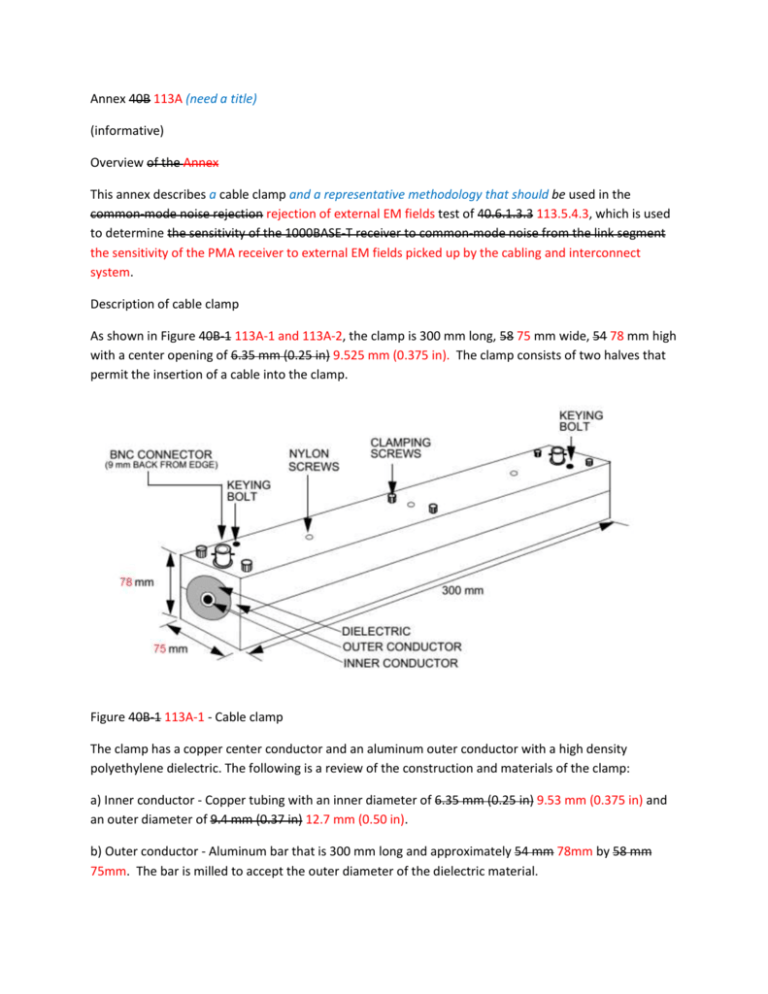text
advertisement

Annex 40B 113A (need a title) (informative) Overview of the Annex This annex describes a cable clamp and a representative methodology that should be used in the common-mode noise rejection rejection of external EM fields test of 40.6.1.3.3 113.5.4.3, which is used to determine the sensitivity of the 1000BASE-T receiver to common-mode noise from the link segment the sensitivity of the PMA receiver to external EM fields picked up by the cabling and interconnect system. Description of cable clamp As shown in Figure 40B-1 113A-1 and 113A-2, the clamp is 300 mm long, 58 75 mm wide, 54 78 mm high with a center opening of 6.35 mm (0.25 in) 9.525 mm (0.375 in). The clamp consists of two halves that permit the insertion of a cable into the clamp. Figure 40B-1 113A-1 - Cable clamp The clamp has a copper center conductor and an aluminum outer conductor with a high density polyethylene dielectric. The following is a review of the construction and materials of the clamp: a) Inner conductor - Copper tubing with an inner diameter of 6.35 mm (0.25 in) 9.53 mm (0.375 in) and an outer diameter of 9.4 mm (0.37 in) 12.7 mm (0.50 in). b) Outer conductor - Aluminum bar that is 300 mm long and approximately 54 mm 78mm by 58 mm 75mm. The bar is milled to accept the outer diameter of the dielectric material. c) Dielectric - High Density Polyethylene (Residual, TypeF) with dielectric constant of 2.32. The hollow cylinder has Aan outside diameter of 33.5 mm 45 mm and an inner diameter that accepts the outside diameter of the copper inner conductor. d) Connectors - BNC connectors are located 9 mm (0.39 in) from each end of the clamp and are recessed into the outer conductor. The center conductor of the connector is connected to the inter inner conductor as shown in Figure 40B-2 113A-2. e) Clamping screws - Six screws are used to connect the two halves of the clamp together after the cable has been inserted. Although clamping screws are shown in Figure 40B-1 113A-1, any clamping method may be used that ensures the two halves are connected electrically and permits quick assembly and disassembly. f) Nylon screws - Used to align and secure the inner conductor and dielectric to the outer conductor. The use and location of the screws is left to the manufacturer. g) Keying bolts - Two studs used to align the two halves of the clamp. Figure 40B-2 113A-2 - Cross-section of cable clamp As shown in Figure 40B-2 113A-2 the inner conductor on the bottom half of the clamp extends slightly (~ 0.1mm) above the dielectric to ensure there is good electrical connection with the inner conductor of the top half of the clamp along the full length of the conductor when the two halves are clamped together. The electrical parameters of the clamp between 1MHz 80MHz and 250 MHz 2GHz are as follows: a) Insertion loss: < 0.2 dB < 5 dB b) Return loss: > 20.0 dB >20.0 dB (80MHz-520MHz), >20.5 – 50log30(f/500) dB (520MHz-2000MHz) 40B.1 113A.1 Cable clamp validation In order to ensure the cable clamp described above is operating correctly, the following test procedure is provided. Prior to conducting the following test shown in Figure 40B-3, 113A-3, the clamp should be tested to ensure the insertion loss and return loss are as specified above. The cable clamp validation test procedure uses a well-balanced 4-pair Category5 unshielded Category 8 test cable or better that meets the specifications of 40.7 113.7. The test hardware consists of the following: a) Resistor network - Network consists of three 50 ±0.1% Ω resistors; two resistors are connected in series as a differential termination for cable pairs and the other resistor is connected between the two and the ground plane as a common-mode termination. Transmitter/Receiver – A link partner system, configured for the data rate being evaluated, with the transmitter disabled. b) Breakout Fixture – A passive fixture with a modular jack input and individual outputs for each of the 8 signal wires. Wires of pairs not being measured should be terminated to the ground plane with a 50 Ω resistor. bc) Balun - 3 ports, laboratory quality with a 100 Ω differential input, 50 Ω differential output, and a 50 Ω common-mode single-ended, unbalanced output: Insertion Loss (100 Ω balanced <-> 50 Ω unbalanced): <1.2 dB (1-350MHz) <4dB (1MHz-3GHz) Return Loss: >20 dB (1-350 MHz) >30dB (1MHz-3GHz) Longitudinal Balance: >50 dB (1-350 MHz) Common-Mode Rejection: >60dB (1MHz-200MHz), >30dB at 3GHz cd) Test cable - 4-pair 100 Ω UTP category 5 S/FTP Category 8 balanced cable at least 30 m long. de) Chokes (2 5) - Wideband Ferrite Material: Inter-Inner diameter: 6.35 to 6.86 mm 8.7 mm to 10.15mm Impedance: 250 Ω @ 100 MHz 175 Ω @ 100 MHz, 275 Ω @ 250 MHz, 375 Ω @ 500 MHz, 400 Ω @ 1000 MHz ef) Ground plane - Copper sheet or equivalent. fg) Signal generator gh) Signal Sensor & Measurement System - Oscilloscope, power meter or spectrum analyzer hi) Receiver Figure 40B-3 113A-3 - Cable clamp validation test configuration With the test cable inserted in the cable clamp, a signal generator with a 50 Ω output impedance is connected to one end of the cable clamp and an oscilloscope a signal sensor with a 50 Ω input impedance is connected to the other end. The signal generator shall be capable of providing a sine wave signal of 1 MHz to 250 MHz 2GHz. The output of the signal generator is adjusted for a voltage of 1.0 Vrms (2.83 Vpp) signal power of 6dBm at 20 80 MHz on the oscilloscope signal sensor. The remainder of the test is conducted without changing the signal generator voltage. The cable pairs not connected to the balun are terminated in a resistor network, although when possible it is recommended that each cable pair be terminated in a balun. It is very important that the cable clamp, breakout fixture and balun , receiver, and resistor networks have good contact with the ground plane. The two chokes, which are located next to each other, are located approximately 2.0 cm from the clamp. The cable between the clamp and the balun should be straight and not in contact with the ground plane. The differential-mode and common-mode voltage outputs of the balun and breakout fixture should meet the limits shown in Table 40B-1 113A-1 over the frequency range 1 80 MHz to 250 MHz 2GHz for each cable pair. The differential mode voltage at the output of the balun must be increased by 3 dB to take into account the 100-to-50 impedance matching loss of the balun. Table 40B-1 113A-1 - Common- and differential-mode output voltages Frequency (f) 80-250 MHz 250MHz-2GHz Common-mode voltage <1.07 – 0.6 (f-80)/170 Vpp <470mVpp (-2.6dBm) Differential-mode voltage <22 mVpp (-29 dBm) <22mVpp NOTE - Prior to conducting the validation test the cable clamp should be tested without the cable inserted to determine the variation of the signal generator voltage with frequency at the output of the clamp. The signal generator voltage should be adjusted to 1.0 Vrms (2.83 Vpp) 6dBm at 20 80 MHz on the oscilloscope signal sensor. When the frequency is varied from 20 MHz to 250 MHz 80MHz to 2GHz, the voltage on the oscilloscope measured power should not vary more than ±7.5% 10%. If the voltage power varies more than ±7.5% 10%, then a correction factor must be applied at each measurement frequency. 113A.2 Test Setup An up to 30-meter, 4-pair Category 8 channel that meets the specification of 113.7 is connected between two 40GBASE-T PHYs and inserted into the cable clamp. The cable should be terminated on each end with an MDI connector plug specified in 113.8.1. The clamp should be located a distance of ~20 cm from the receiver. It is recommended that the cable between the transmitter and the cable clamp be installed either in a linear run or wrapped randomly on a cable rack. The cable rack should be at least 3 m from the cable clamp. In addition, the cable clamp and 40GBASE-T receiver should be placed on a common ground plane and the ground of the receiver should be in contact with the ground plane. The chassis grounds of all test equipment used should be connected to the ground plane. No connection is required between the ground plane and an external reference. A signal generator with a 50Ω impedance is connected to one end of the clamp and measurement equipment with a 50Ω input is connected to the other end of the clamp. The signal generator shall be capable of providing a sine wave signal of 80 MHz to 2 GHz. The output of the signal generator is adjusted for a signal power not to exceed 6 dBm at the signal sensor to simulate an external electromagnetic field of approximately 3 V/m. Figure 113A-4 - Cable clamp test configuration






